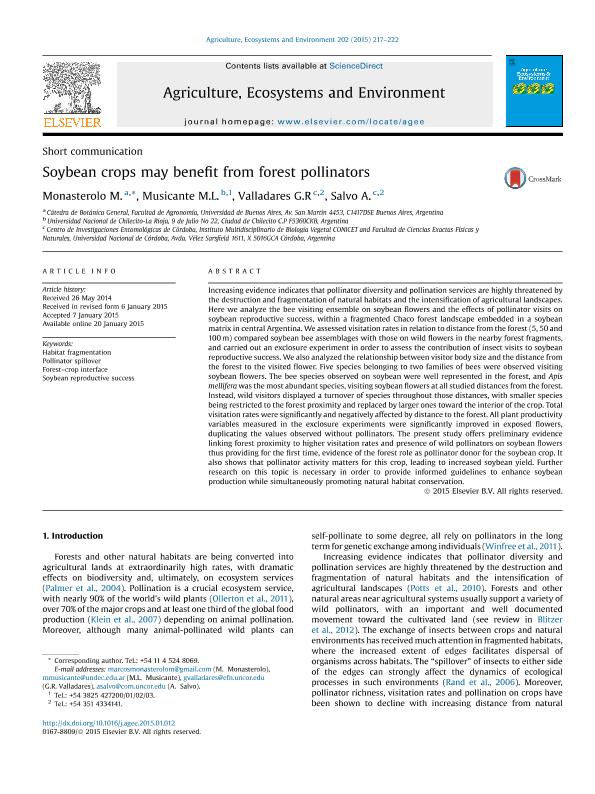Mostrar el registro sencillo del ítem
dc.contributor.author
Monasterolo, Marcos

dc.contributor.author
Musicante, Mariana Laura

dc.contributor.author
Valladares, Graciela Rosa

dc.contributor.author
Salvo, Silvia Adriana

dc.date.available
2017-04-18T17:51:40Z
dc.date.issued
2015-04
dc.identifier.citation
Monasterolo, Marcos; Musicante, Mariana Laura; Valladares, Graciela Rosa; Salvo, Silvia Adriana; Soybean crops may benefit from forest pollinators; Elsevier Science; Agriculture, Ecosystems And Environment; 202; 4-2015; 217-222
dc.identifier.issn
0167-8809
dc.identifier.uri
http://hdl.handle.net/11336/15369
dc.description.abstract
Increasing evidence indicates that pollinator diversity and pollination services are highly threatened by the destruction and fragmentation of natural habitats and the intensification of agricultural landscapes. Here we analyze the bee visiting ensemble on soybean flowers and the effects of pollinator visits on soybean reproductive success, within a fragmented Chaco forest landscape embedded in a soybean matrix in central Argentina. We assessed visitation rates in relation to distance from the forest (5, 50 and 100m) compared soybean bee assemblages with those on wild flowers in the nearby forest fragments, and carried out an exclosure experiment in order to assess the contribution of insect visits to soybean reproductive success. We also analyzed the relationship between visitor body size and the distance from the forest to the visited flower. Five species belonging to two families of bees were observed visiting soybean flowers. The bee species observed on soybean were well represented in the forest, and Apis mellifera was the most abundant species, visiting soybean flowers at all studied distances from the forest. Instead, wild visitors displayed a turnover of species throughout those distances, with smaller species being restricted to the forest proximity and replaced by larger ones toward the interior of the crop. Total visitation rates were significantly and negatively affected by distance to the forest. All plant productivity variables measured in the exclosure experiments were significantly improved in exposed flowers, duplicating the values observed without pollinators. The present study offers preliminary evidence linking forest proximity to higher visitation rates and presence of wild pollinators on soybean flowers thus providing for the first time, evidence of the forest role as pollinator donor for the soybean crop. It also shows that pollinator activity matters for this crop, leading to increased soybean yield. Further research on this topic is necessary in order to provide informed guidelines to enhance soybean production while simultaneously promoting natural habitat conservation.
dc.format
application/pdf
dc.language.iso
eng
dc.publisher
Elsevier Science

dc.rights
info:eu-repo/semantics/openAccess
dc.rights.uri
https://creativecommons.org/licenses/by-nc-nd/2.5/ar/
dc.subject
Habitat Fragmentation
dc.subject
Pollinator Spillover
dc.subject
Forest-Crop Interface
dc.subject
Soybean Reproductive Success.
dc.subject.classification
Ecología

dc.subject.classification
Ciencias Biológicas

dc.subject.classification
CIENCIAS NATURALES Y EXACTAS

dc.title
Soybean crops may benefit from forest pollinators
dc.type
info:eu-repo/semantics/article
dc.type
info:ar-repo/semantics/artículo
dc.type
info:eu-repo/semantics/publishedVersion
dc.date.updated
2017-04-12T17:59:34Z
dc.journal.volume
202
dc.journal.pagination
217-222
dc.journal.pais
Países Bajos

dc.journal.ciudad
Amsterdam
dc.description.fil
Fil: Monasterolo, Marcos. Universidad de Buenos Aires. Facultad de Agronomia; Argentina
dc.description.fil
Fil: Musicante, Mariana Laura. Universidad Nacional de Chilecito; Argentina
dc.description.fil
Fil: Valladares, Graciela Rosa. Universidad Nacional de Córdoba. Facultad de Ciencias Exactas, Físicas y Naturales; Argentina. Consejo Nacional de Investigaciones Científicas y Técnicas. Centro Científico Tecnológico Córdoba. Instituto Multidisciplinario de Biología Vegetal (p); Argentina
dc.description.fil
Fil: Salvo, Silvia Adriana. Universidad Nacional de Córdoba. Facultad de Ciencias Exactas, Físicas y Naturales; Argentina. Consejo Nacional de Investigaciones Científicas y Técnicas. Centro Científico Tecnológico Córdoba. Instituto Multidisciplinario de Biología Vegetal (p); Argentina
dc.journal.title
Agriculture, Ecosystems And Environment

dc.relation.alternativeid
info:eu-repo/semantics/altIdentifier/url/http://www.sciencedirect.com/science/article/pii/S0167880915000134
dc.relation.alternativeid
info:eu-repo/semantics/altIdentifier/doi/http://doi.org/10.1016/j.agee.2015.01.012
Archivos asociados
